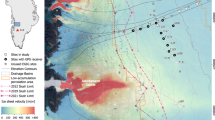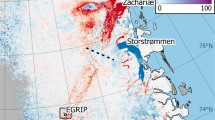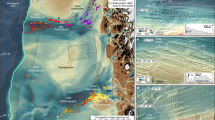Abstract
DURING the Nepal Himalaya P-29 (7,835m) Expedition of Osaka University Mountaineering Club, 1961, we had some experience on sliding and avalanches of an active ice-fall; analysing photographs taken by a Canon 2,000mm telephotographic lens from the base camp at 4,400 m high. Fig. 1 is a series of photographs taken at: (a) May 10, 1° 30′ p.m.; (b) May 11, 9° 30′ a.m.; (c) the same day 11° 30′ just after a small avalanche. By comparing the photographs (a) and (b) we can see that the glacier ice slid down as shown in Fig. 2. The distance of sliding on the original photograph was 2.0 mm. As the distance from the base camp to the ice-fall was 4 km, it corresponds to 4 m. As the estimated slope was 60°, the speed of sliding of the ice-fall became 6 m/day. Evidently this value is too large compared with the usual velocity of flow of a glacier. But as an avalanche occurred immediately afterwards, this value may not be unreasonable and gives some information on mobility of an ice-fall during the pre-avalanche period.
This is a preview of subscription content, access via your institution
Access options
Subscribe to this journal
Receive 51 print issues and online access
$199.00 per year
only $3.90 per issue
Buy this article
- Purchase on Springer Link
- Instant access to full article PDF
Prices may be subject to local taxes which are calculated during checkout
Similar content being viewed by others
Author information
Authors and Affiliations
Rights and permissions
About this article
Cite this article
SHINODA, G. Velocity of Sliding of an Ice-fall. Nature 199, 165–166 (1963). https://doi.org/10.1038/199165b0
Issue Date:
DOI: https://doi.org/10.1038/199165b0
Comments
By submitting a comment you agree to abide by our Terms and Community Guidelines. If you find something abusive or that does not comply with our terms or guidelines please flag it as inappropriate.



